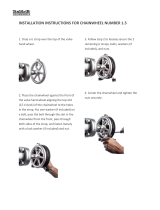
8 www.maxwellmarine.com
“Star-delta” and “soft starters” are not recommended for starting windlass motors, as the motor torque
is severely limited during start up period. Since these motors often have to start under load (when
retrieving the ground tackle), they might not be able to move until they reach the full voltage and
torque. The benefit of starting at lower current would therefore be lost. Also, the motor brake would
release immediately on start-up, which could cause short movement of the chain in opposite direction.
The Variable Frequency Drives (VFD) offer accurate control of current during start up period while
keeping high motor torque. They also offer various other benefits like:
infinite speed control
running the windlass over its nominal speed
accurate current overload and thermal overload control
Both “Direct On Line” starters and Variable Frequency Drives are suitable and available from Maxwell,
customised to suit the anchor windlass and stern capstan application.
! The selection of the type of motor starter should be done by a qualified electrical engineer, taking into
consideration the power generating capacity on board. Maxwell offers both advice and different types of
custom made starters to complement our windlasses.
! The “up” and “down” start contactors must be mechanically or electrically interlocked to safeguard the
motor, in the event that an accidental attempt is made to start the motor in both directions simultaneously.
2.7 POWER CONNECTIONS TO AC MOTOR
Remove the motor terminal box cover and take care not to misplace the sealing gasket and screws.
Select a suitably sized, waterproof cable gland for the armoured supply cable. The selected gland
fitting must fit the terminal box, be capable of anchoring the armoured cable, and allow an effective
waterproof entry seal to be made.
Make the line connections to motor terminals. Make also an effective earth connection.
Separately and similarly, enter the 2 thermistor cables to the motor terminal box, and connect to the
two auxiliary terminal connectors of the thermistor circuit.
Check:
Is the direction of rotation of the motor correct?
Are cables satisfactorily fixed?
Are cable entry points to motor terminal box satisfactorily waterproofed?
Spray the cable gland, cable entry points and motor terminal box with anti-corrosive waterproof
coating "CRC 3013 Soft Seal" or equivalent.
2.8 POWER CONNECTIONS TO HYD MOTOR
A basic hydraulic schematic is shown in Appendix C.
Port sizes on the hydraulic motor and minimum hose sizes are specified in Section 1.3.
The motor has pressure and return ports (bigger) and a case drain ports. The pressure and return
ports should be connected to a solenoid controlled valve (not supplied by Maxwell).
After connecting the power lines, spray all ports and fittings with anti-corrosive waterproof coating,
“CRC 3013 Soft Seal” or equivalent.
2.9 NOTE TO BOAT BUILDER
Experience has shown that, on long ocean deliveries, sulphur from the ship's exhaust can settle on
polished surfaces, which can affect the quality of the finish.
Please ensure that, upon completion of installation, the windlass is treated with suitable corrosion
protective coating (“CRC 3097 Long Life”) and wrapped in plastic film. This ensures that your
customer receives the windlass from you in the same top quality condition as you received it from
Maxwell.























